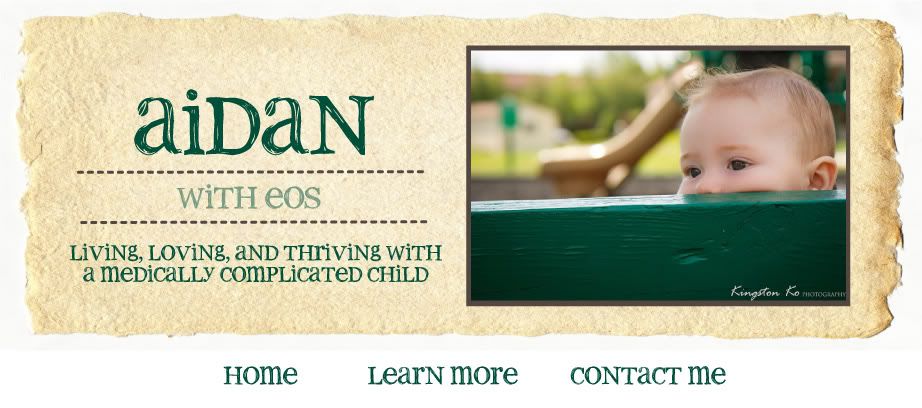The other day, Megan and I took Aidan to lunch with us. We do this often, because he's generally a well-behaved lunch buddy. He watches Blue's Clues or plays Peekaboo Barn on my iPhone while we eat, then we feed his tube. It's a routine we're all pretty comfortable with, and it doesn't generally attract much attention, because we're the subtle types.
On this particular occasion, we were approached by a woman and her young daughter. The little girl was probably about 3 or 4, and they walked up behind Aidan as he was being fed. Every muscle in my body tensed as I waited for whatever ignorant, uninformed, or flat-out rude comment was about to come our way. People seem to say the most idiotic things when they see something outside of their (very narrow view of) normal.
I was wrong. I've never been so glad to be wrong :)
This woman and her daughter were patiently standing behind Aidan, waiting for the right moment to tell us that they knew what we were going through, and that they'd been through it too. The little girl was NG-tube fed for a year (a YEAR on an NG, which basically means this woman should be nominated for sainthood or something, because I don't know if we've all forgotten or not, but Aidan pulled that sucker out like seventy times a day). What they wanted to tell us was that they'd been through it and that it got better.
Obviously their situation was different than ours - no two situations are the same - and I don't think we'll be tube-free in the next year - but I can't get over how kind it was of this mother to pass along some hope. She told me that someone once did it to her - stopped her in a mall and let her know that their child had been a tubie and that it got better for them. It meant so much to her that she decided to do it too, if she ever got the chance.
I've come to think of this as Paying the Sunshine Forward, and I hope to get the chance to do it soon, myself.
Have you run into other tubies out and about? Will you be Paying some Sunshine Forward and giving some hope to a family that's just starting down a path that you've already traveled? I'd really love to hear about it :)
On this particular occasion, we were approached by a woman and her young daughter. The little girl was probably about 3 or 4, and they walked up behind Aidan as he was being fed. Every muscle in my body tensed as I waited for whatever ignorant, uninformed, or flat-out rude comment was about to come our way. People seem to say the most idiotic things when they see something outside of their (very narrow view of) normal.
I was wrong. I've never been so glad to be wrong :)
This woman and her daughter were patiently standing behind Aidan, waiting for the right moment to tell us that they knew what we were going through, and that they'd been through it too. The little girl was NG-tube fed for a year (a YEAR on an NG, which basically means this woman should be nominated for sainthood or something, because I don't know if we've all forgotten or not, but Aidan pulled that sucker out like seventy times a day). What they wanted to tell us was that they'd been through it and that it got better.
Obviously their situation was different than ours - no two situations are the same - and I don't think we'll be tube-free in the next year - but I can't get over how kind it was of this mother to pass along some hope. She told me that someone once did it to her - stopped her in a mall and let her know that their child had been a tubie and that it got better for them. It meant so much to her that she decided to do it too, if she ever got the chance.
I've come to think of this as Paying the Sunshine Forward, and I hope to get the chance to do it soon, myself.
Have you run into other tubies out and about? Will you be Paying some Sunshine Forward and giving some hope to a family that's just starting down a path that you've already traveled? I'd really love to hear about it :)

.jpg)


